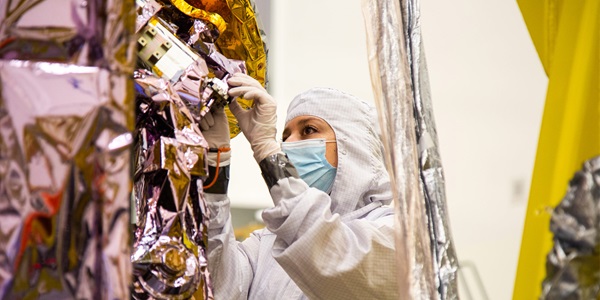Webb's Backbone

By Amanda Collins
The James Webb Space Telescope (Webb) is the closest thing we have to time travel, capturing images that offer a glimpse of the origins of the universe.
It’s no accident that Webb’s images are so crisp. This ability is made possible in part by Webb’s revolutionary structures: the backplane and integrated science instrument module which hold the spacecraft motionless so it can see far into deep space. These support structures — and the people who engineered them — are the unsung heroes of Webb’s stellar performance.

Design Innovation
Program Manager Bob Hellekson has been with Webb’s composite structures program since the beginning.
“Webb is the equivalent of our Super Bowl win,” said Bob, although he noted that even that comparison doesn’t do Webb’s significance justice. “Webb is a point of pride for all Northrop Grumman employees – whether you worked directly on it or not, chances are, you’ve been touched by its success.”
The optical precision needed by Webb is unprecedented. Carrying 2.5 tons of hardware, the structures cannot expand or contract more than 1/10,000 of the diameter of a human hair despite extreme temperatures of below -400 degrees Fahrenheit.
Lightweight graphite composites were a natural choice for the structures because these composites are very strong and barely respond to differences in temperature. The open framework of the design allowed technicians to move freely inside the structure during spacecraft integration and kept the lines of sight from the telescope to the spacecraft instruments clear.
Still, holding Webb steady enough to erase the boundaries of our known universe required results far beyond your average composite. Even with the right starting material, the design and manufacturing had to be innovative.
“It’s not just the materials, it’s the assembly,” said Brian Jahne, the lead mechanical design engineer on the composite structures.
Too much adhesive wouldn’t survive the icy recesses of space, but too little adhesive could mean the bond might not survive the stresses of the launch. Get the glue too close to the edge of the seam and it’s game over.
“We had to develop a new way of injection bonding to precisely control the spread of the adhesive,” said Brian, recalling one of the team’s many innovations that supported successful assembly.

Proof Points
In space, you can’t just assume something will work — you must prove it through extensive testing. Webb’s analysis presented first-ever challenges because the test requirements were so small.
Lead Analysis Engineer Austin Van Otten traveled back and forth from Northrop Grumman’s Magna, Utah, site to the NASA facility outside of Huntsville, Alabama, to support testing, which ran 24/7 once started.
“It was challenging to balance the performance requirements, from the significant launch loads to the space operating environments and just plain survivability of the parts,” he said. “But it was a resounding success. Every single one of the more than 10,000 bonds in the structure survived.”
Webb was a constant in the lives of those who worked on it — the program that fueled their workloads for decades. The breathtakingly sharp imagery being captured by Webb is the real finish line for the composite structures team.
“I know lots of people breathed a sigh of relief when the spacecraft was successfully deployed, but, for me, it wasn’t until those first images that I took a big, deep breath, because then I knew our work had paid off,” said Austin, who joined the team right out of graduate school.
Seeing the impact of their work on the scientific community is “mind-blowing,” said Brian, who is excited by the new areas of discovery sparked by Webb. For the team, it makes their dedication even more meaningful.
“It was a lot of my life for a while, through the birth of my first child and beyond,” said Austin. “All that time and effort invested will now bring benefits for generations to come.”
Photos courtesy of NASA/Chris Gunn.


